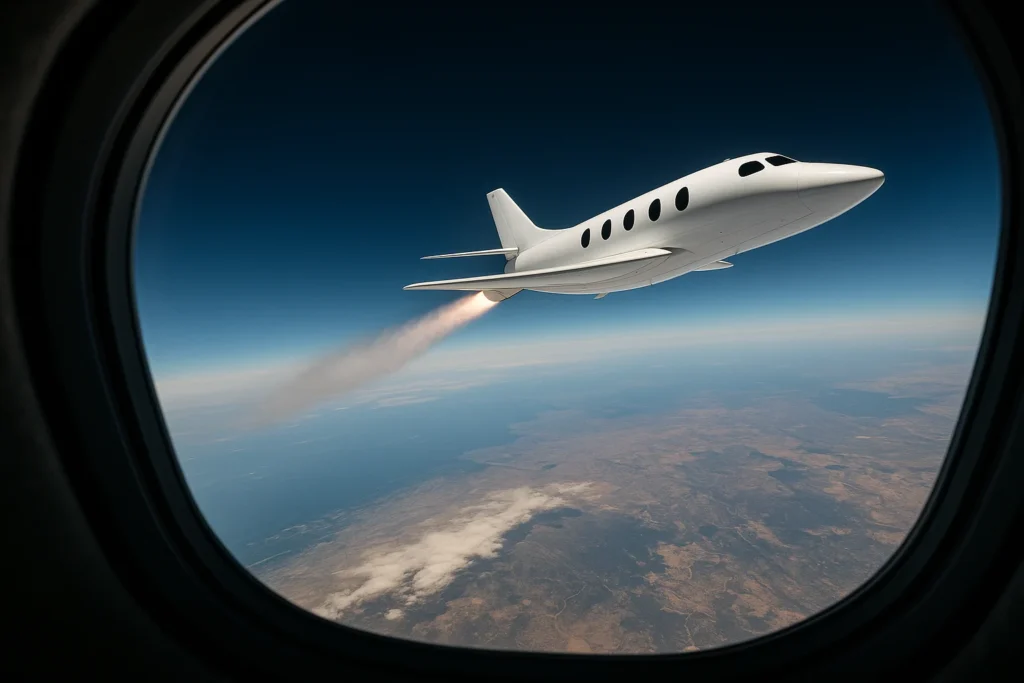Introduction: Humanity’s New Frontier of Travel
For generations, the dream of traveling to space belonged only to a select few, rigorously trained astronauts who pushed the boundaries of human exploration. We watched their launches with bated breath, dreaming of the day we too could see Earth from above. In 2025, that dream has, for a lucky few, become a reality. After years of relentless testing and development, companies like Blue Origin, SpaceX, and Virgin Galactic have officially launched regular commercial suborbital flights, opening a breathtaking new chapter in human history: space tourism has truly gotten real.
This isn’t just about a joyride for the ultra-wealthy. It marks a pivotal new era in both luxury travel and aerospace development, transforming our relationship with space from a realm of government agencies to a burgeoning commercial marketplace. But what’s it really like to cross the Kármán line, the invisible boundary of space? What does it cost, what are the risks, and what does this mean for our planet and our future among the stars?
First Glimpses: What It’s Really Like Above the Kármán Line
The moment of crossing into space is often described by astronauts as profoundly transformative, an “overview effect” that shifts perspectives. Now, the first public passengers are sharing their raw, emotional accounts of what it’s truly like to venture beyond Earth’s atmosphere.
A Journey Beyond Words
Imagine strapping into a sleek, powerful rocket, the rumble beneath you growing from a tremor to a mighty roar. The G-forces press you back into your seat, a sensation unlike anything on Earth. Then, suddenly, the engines quiet. The pressure lifts. You float. This is the experience of microgravity, where pens, water, and even you yourself, gently drift.
From the large panoramic windows, the view is breathtaking. The Earth curves majestically below, a vibrant blue and white marble against the inky blackness of space. There are no borders, no political lines – just a fragile, beautiful planet. Many describe a profound sense of awe and interconnectedness. For a few glorious minutes, you are weightless, gazing at your home world from a perspective previously reserved for a handful of government-trained individuals. Then, the gentle pull of gravity begins to return as the spacecraft arcs back towards Earth, leading to a controlled descent and a surprisingly smooth landing.
These initial passenger flights from companies like Virgin Galactic (with their SpaceShipTwo, Unity) and Blue Origin (with their New Shepard rocket) are providing invaluable insights, not just into the technical aspects of spaceflight, but into the profound human experience of leaving our planet. These stories are critical for inspiring the next wave of space travelers and showing the world what’s truly possible.
The Price of Admission: Logistics for the Cosmic Tourist
While the experience of space tourism is now available, it’s certainly not cheap, and getting there involves more than just buying a ticket. Aspiring space tourists must consider the significant prices, the necessary training, stringent health screenings, and what to expect regarding onboard conditions.
Beyond a First-Class Ticket
- The Cost of the Cosmos: In 2025, the price tag for a suborbital journey remains firmly in the luxury market. A seat on a Virgin Galactic flight typically hovers around $450,000. While Blue Origin’s pricing is less publicly advertised for individual seats, it’s expected to be in a similar range. For those dreaming of orbital flights (like those offered by SpaceX’s Inspiration4 mission or future civilian missions on Starship), the cost scales into the millions of dollars per seat, making it accessible only to a tiny fraction of the global population.
- Training for the Edge: Unlike professional astronauts who train for years, suborbital space tourists undergo relatively brief but intensive preparation. This typically lasts a few days to a few weeks, focusing on:
- Safety Protocols: Understanding emergency procedures and cabin rules.
- G-force Tolerance: Experiencing simulators that replicate the forces of launch and re-entry.
- Microgravity Familiarization: Learning how to move and operate in weightlessness.
- Mission Briefings: Understanding each stage of the flight.
- Health Screenings: Prospective space tourists must pass rigorous health screenings. These include comprehensive physical fitness tests, psychological evaluations, and medical checks to rule out any conditions (like severe heart problems or respiratory issues) that could be exacerbated by the stresses of spaceflight, including high G-forces during ascent and descent.
- Onboard Conditions: Passengers spend most of their journey seated. The key experience is the several minutes of microgravity once the engine cuts off, allowing passengers to unbuckle and float. Large windows provide unparalleled views of Earth’s curvature and the blackness of space. The flight itself is relatively short – a suborbital journey typically lasts about 10-15 minutes from launch to landing, with the actual time in space measured in mere minutes.
These practicalities define the exclusivity of early space tourism, but they also lay the groundwork for future scalability and potentially lower costs as technology advances and competition increases.
Environmental Footprint: Rockets, Emissions, and Sustainability
As commercial space flights become more frequent, a critical conversation is emerging about their environmental concerns. While impressive, launching rockets involves significant energy consumption and produces emissions that prompt questions about long-term sustainability.
The Sky’s the Limit, But At What Cost?
- Rocket Emissions: Unlike aircraft, rockets release their exhaust gases at very high altitudes, directly into the stratosphere and mesosphere. The primary concerns include:
- Soot (Black Carbon): Solid rocket fuels and even some liquid fuels produce soot particles, which can linger at high altitudes and potentially contribute to atmospheric warming and ozone depletion.
- Nitrogen Oxides: High temperatures during launch create nitrogen oxides, which can also impact the ozone layer.
- Water Vapor: While seemingly benign, water vapor released in the stratosphere can also contribute to the formation of high-altitude clouds that trap heat.
- Chlorine: Older solid rocket boosters used in the past released chlorine, a known ozone-depleting substance. While less common in modern commercial systems, it remains a historical concern.
- Frequency and Scale: Currently, the number of commercial space tourism launches is relatively low compared to other forms of transportation or industrial emissions. However, as the industry scales up with potentially thousands of launches annually in the decades to come, the cumulative environmental impact becomes a more significant concern.
- Sustainability Solutions: The aerospace industry is actively researching more sustainable propulsion methods, including:
- Methane-based fuels: Often considered cleaner than kerosene or solid fuels.
- Electric or hybrid launch systems: Though still largely theoretical for large-scale spaceflight.
- Reusability: Companies like SpaceX (and Blue Origin) focus on reusable rockets, which significantly reduces the carbon footprint per launch compared to single-use rockets.
- Offsets and Carbon Capture: Some companies are exploring carbon offsetting programs or future technologies to capture emissions.
While space tourism’s current environmental footprint is small, its rapid growth necessitates proactive research and development into greener launch technologies and robust sustainability practices to ensure a future where space exploration doesn’t come at an unacceptable cost to our planet.
Beyond the Joyride: Impact on Science and Infrastructure
The rise of commercial space tourism isn’t just about fulfilling human dreams of flight; it’s also poised to have a profound impact on future scientific research and the development of commercial space infrastructure. This emerging industry is paving the way for more frequent, flexible, and affordable access to the unique environment of space.
Building the Off-World Economy
- Democratizing Research Access: Historically, access to microgravity for scientific experiments was limited to government-sponsored missions, often with long lead times and high costs. Commercial suborbital flights, and increasingly orbital flights, offer:
- More Frequent Flights: Scientists can launch experiments more often, allowing for faster iterations and data collection.
- Reduced Costs: While still expensive, the cost per experiment is significantly lower than a full NASA mission.
- New Research Areas: This opens up new possibilities for research in areas like materials science, fluid dynamics, biology, and pharmaceuticals, where microgravity can reveal insights impossible on Earth.
- Building Space Infrastructure: The development of commercial space tourism directly contributes to a robust commercial space infrastructure. This includes:
- Launch and Landing Sites: Expansion of private spaceports and ground support facilities.
- Vehicle Development: Ongoing innovation in rocket design, reusability, and manufacturing.
- Training Facilities: Development of training centers for private astronauts and supporting personnel.
- Supply Chains: Growth of a commercial ecosystem that supports space launches. This infrastructure is not only for tourism but also for satellite deployment, space manufacturing, in-orbit servicing, and eventually, more ambitious deep-space missions.
- Lowering Barriers to Space: By making space more accessible, commercial tourism fosters innovation, attracts new talent, and broadens public engagement with space, creating a larger and more diverse pool of individuals invested in space exploration.
In essence, space tourism acts as a powerful economic engine, accelerating the development of technologies and infrastructure that benefit a much wider range of scientific and commercial endeavors in space.
Dreaming Deeper: Lunar Hotels and Martian Tourism?
The advent of suborbital space tourism raises the ultimate question: Is this just the beginning? Are we truly on a path towards a future where lunar hotels and Martian tourism become a reality, transforming humanity into a multi-planetary species?
The Long Arc of Space Exploration
- A Critical First Step: Current suborbital flights, while exhilarating, are akin to the first short airplane hops compared to transatlantic travel. They are crucial for gaining experience with commercial operations, passenger training, and routine launches. The technology and operational knowledge gained from these “edge of space” flights are foundational.
- Orbital and Beyond: The next logical step, already being pursued by companies like SpaceX with its Starship, is regular orbital tourism. This would involve spending days or weeks in Earth orbit, potentially on private space stations. These orbital missions would require entirely new levels of life support, radiation shielding, and logistics.
- The Lunar Leap: For lunar hotels or lunar tourism, the technological leap is immense. This would require:
- Heavy-lift rockets: Capable of sending significant payloads to the Moon.
- Lunar landers: For safe descent and ascent from the Moon’s surface.
- Habitats: Sustainable living environments on the Moon, protected from radiation and extreme temperatures.
- Closed-loop life support: Systems to recycle air, water, and waste.
- Space resources utilization: Potentially using lunar resources for fuel or building materials. While ambitious, concepts for lunar bases and even hotels are on drawing boards, possibly becoming a reality in the latter half of the 21st century.
- The Martian Dream: Martian tourism is an even more distant and complex prospect. A journey to Mars involves years in deep space, extreme radiation exposure, and the establishment of self-sustaining colonies. This is truly the domain of future generations, requiring scientific breakthroughs and vast international cooperation.
So, while lunar hotels and Martian tourism remain ambitious dreams, the current commercial suborbital flights are undeniably a vital stepping stone, proving the economic viability and public demand that will drive humanity’s longer journey into the cosmos.
Governing the Cosmos: Regulatory Developments and Global Policies
As the final frontier opens to commercial players, the need for clear rules and regulations becomes paramount. In 2025, regulatory developments and global space travel policies are being shaped in real time, aiming to ensure safety, manage traffic, and clarify responsibilities in this rapidly evolving domain.
Charting Uncharted Legal Skies
- National Oversight (e.g., FAA): In the United States, the Federal Aviation Administration (FAA) is the primary regulatory body for commercial space launches. Its role is to ensure public safety during launch and re-entry operations. For space tourists, the FAA currently operates under an “informed consent” model, meaning passengers must be aware of and accept the risks associated with commercial spaceflight. The focus is on protecting the public on the ground and in the air, rather than dictating passenger safety standards in space (which are expected to improve as the industry matures).
- Evolving Safety Standards: As flights become more routine, there’s growing pressure for more specific safety standards for commercial passenger spaceflight, moving beyond just informed consent. Industry bodies, in collaboration with regulators, are working on best practices for vehicle design, crew training, and operational procedures.
- International Cooperation and Treaties: Space doesn’t respect national borders, and as more countries and private companies launch vehicles, international cooperation is crucial. Discussions are ongoing within the United Nations Office for Outer Space Affairs (UNOOSA) and other forums about:
- Space Traffic Management: Preventing collisions in orbit as the number of satellites and spacecraft increases.
- Liability: Clarifying who is responsible in the event of an accident involving private citizens or multiple nations.
- Environmental Protection: Developing global standards for mitigating space debris and regulating rocket emissions.
- Resource Utilization: Debating the legal framework for using resources from the Moon or asteroids.
- Future Policy Challenges: As space tourism potentially expands to orbital hotels or lunar excursions, new policy challenges will arise, including jurisdiction in outer space, commercial property rights beyond Earth, and rescue protocols for space emergencies.
The dynamic nature of space tourism means that legal and policy frameworks must adapt quickly, ensuring that innovation can thrive safely and responsibly in this exciting new era.
Conclusion: The Sky is No Longer the Limit
In 2025, the era of space tourism has truly gotten real, marking a monumental shift in how humanity interacts with the cosmos. Companies like Blue Origin, SpaceX, and Virgin Galactic have moved beyond tests, launching regular commercial suborbital flights that transform the dream of seeing Earth from above into a tangible, albeit luxurious, reality. The exhilaration of the first public passengers floating above the Kármán line underscores a profound new human experience, one that is becoming more accessible, albeit still at high prices and with strict training and health screenings.
This burgeoning industry is not without its challenges. Growing environmental concerns over rocket emissions demand a focus on sustainable practices, while the impact on future scientific research and commercial space infrastructure promises a broader benefit beyond just tourism. As we gaze forward, these suborbital flights are undeniably a critical first step towards grander visions of lunar hotels and even Martian tourism, pushing the boundaries of what’s possible in human exploration. Finally, the rapid pace of development necessitates continuous regulatory developments and global space travel policies, ensuring safety, managing risk, and shaping the future of off-world travel in real time.
The sky is no longer the limit; it is merely the starting line for a new age of space exploration and adventure, driven by commerce and the enduring human desire to reach for the stars.



